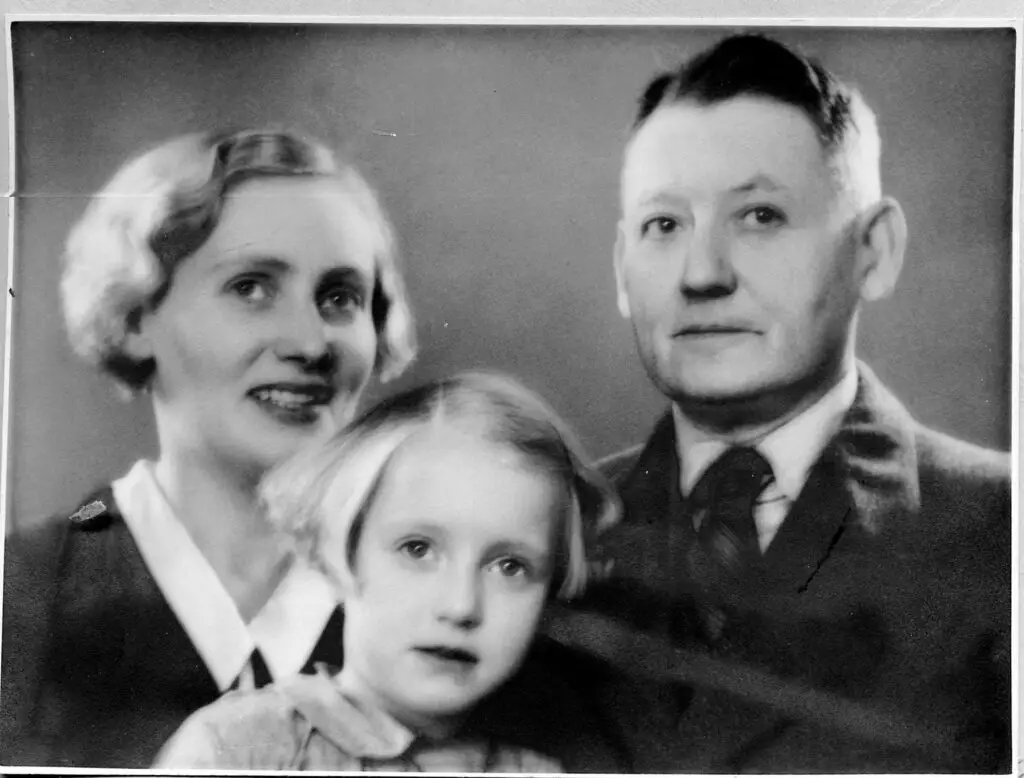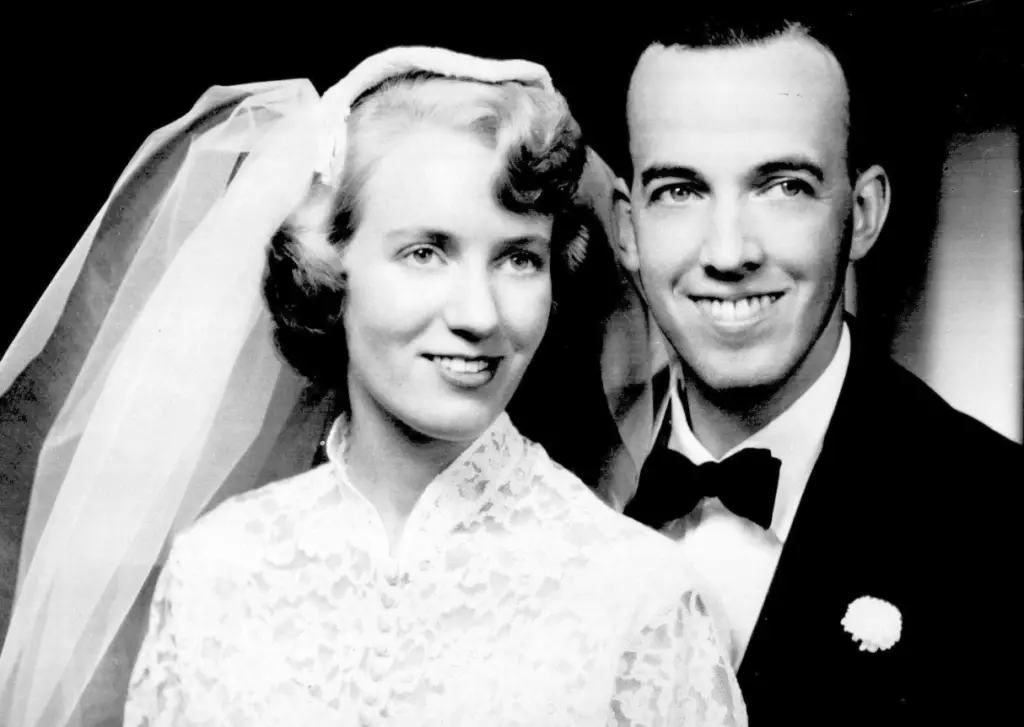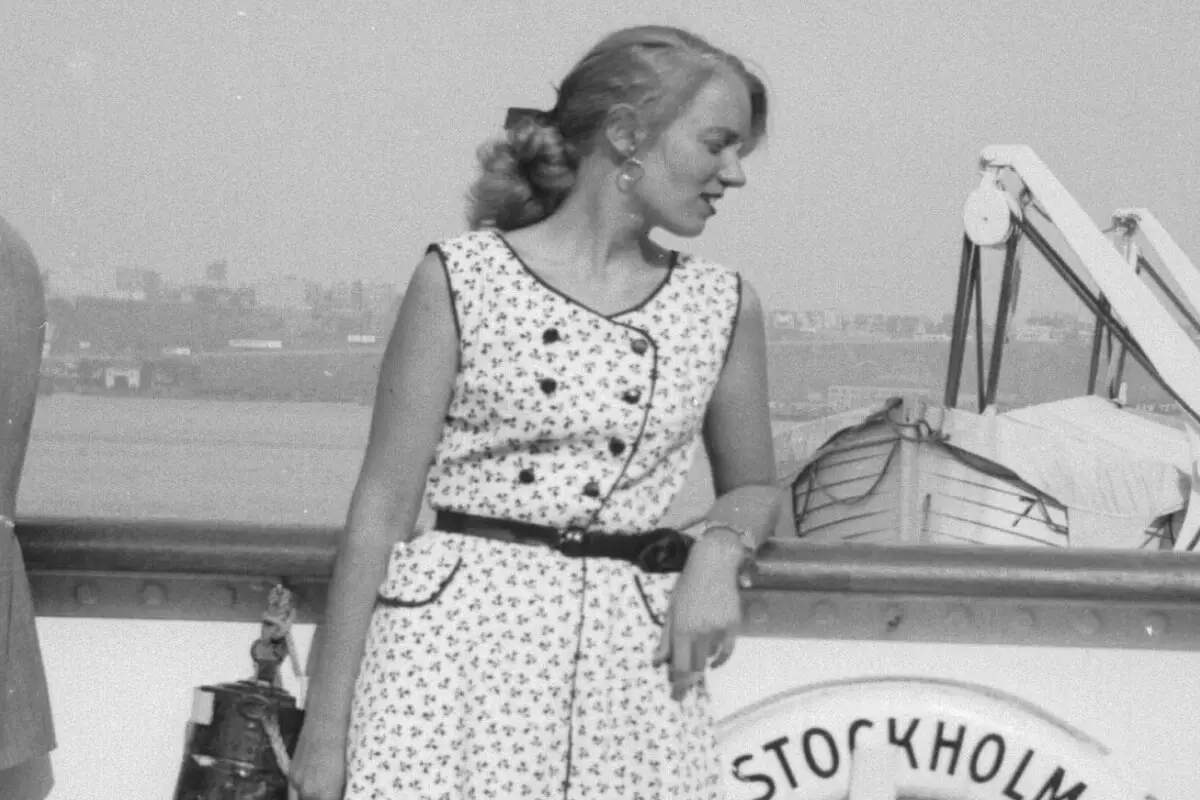Would you have the courage to travel alone to America at age 20 when you couldn’t speak much English? My grandmother, Anne Marie, was born in 1931 in Stockholm, Sweden. She lived in Sweden until 1952 when she decided to go to America.
In the 1950s, American movies and music were very popular in Europe. Many people from Sweden wanted to learn English. Anne-Marie’s friend Vera was crazy about anything American, and she wanted to learn to speak English better.
Table of Contents
- Traveling To America in the 1950s
- The Stockholm Vessel to The United States (1952)
- A Nanny in Boston in 1952
- Working in Washington DC
- Meeting Sharman B (1953)
- Frequently Asked Questions
- Related Content

Traveling To America in the 1950s
Her friend Vera got a job as a nanny in Boston, Massachusetts, for one year and she didn’t want to go alone, so she convinced Anne-Marie to join her on an adventure in America. Anne-Marie had many interesting experiences while traveling to America and while working different jobs there; she ended up staying in America.
Anne-Marie, like many young Swedes, enjoyed American music and movies. Her friend Vera wanted to visit America, and she convinced Anne-Marie to go to America with her. At this time in Sweden, Anne-Marie was finishing high school and was working as a secretary at an Engineering firm. She did not like her job and was happy to quit her job and go to America for an adventure.
Vera had a job lined up as a nanny in Boston, and she helped Anne-Marie find a nanny job there too. They committed to work as nannies in Boston for one year.
The Stockholm Vessel to The United States (1952)
Vera’s job was delayed by a month, so Anne-Marie had to travel to America alone at 20. She went on the vessel named Stockholm in April 1952. There were about 600 people on the ship, and it took one week to get to America.
Most of the passengers spoke Swedish, and she was assigned a Swedish roommate who was traveling to marry an American. She and her Swedish roommate and another Swedish young man they met watched movies and went to dances on the ship for entertainment.
There was a big storm, and many passengers got sick, and she was nervous about the ship’s rocking. She also remembers the dining room tables had an edge around them, and the tablecloths were wet so their plates wouldn’t slide.
The vessel arrived in America, and everyone ran to see the Statue of Liberty. As she exited the ship, a man stood by the ship and welcomed all the passengers, saying, “Why don’t you go back where you belong!”

A Nanny in Boston in 1952
The family Anne-Marie was nannying for picked her up in New York City. They drove her to their home in Boston near Harvard.
The family had three boys, ages 5, 8, and 11. The parents were professionals. She didn’t think they were very friendly and often felt lonely and uncomfortable. Anne-Marie felt the family treated her like a servant.
She did household chores such as cooking and cleaning. The mother helped the children with their schoolwork. Anne-Marie had her room upstairs. Although she had studied English for three years in high school, she could not communicate well. She had every other weekend off. She looked forward to her weekends off, which she spent with Vera.
Anne-Marie and her parents would write to each other about once a week. After nine months, Vera’s family was relocated to Brazil for work.
Working in Washington DC
Anne-Marie quit her nanny job and went with Vera to Washington, DC. Because they quit their nanny jobs, Vera and Anne-Marie had to buy their return tickets to Sweden.
They took a bus to Washington, DC, and found a community house to stay in. There were six girls and one bathroom in the house.
Anne-Marie and Vera got secretarial jobs at the headquarters of the Daughters of the American Revolution. Anne-Marie also got a night job at a clothing department store to help her earn money to purchase her ticket back to Sweden. This job was very difficult for her. She was a salesperson and had to write tickets for layaways.
Anne-Marie had difficulty writing the name and address the customers would tell her. She was also very embarrassed and self-conscious about her accent. On the weekends, she and Vera, and their American roommates would go to dances. She found it hard to get around without a car. Anne-Marie liked America, although she sometimes felt like a foreigner and wanted to return to Sweden.

Meeting Sharman B (1953)
In 1953, Anne-Marie met Sharman at a Sunday afternoon tea party for international students at a Friends Quaker meeting. She began visiting with Sharman even though she thought he was strange. He offered to walk Anne-Marie and her friend home. He asked her for her telephone number.
Sharman became ill, and Anne-Marie did not hear from him for months. However, he sent her a box of candy on Valentine’s Day. He then asked her out, and they started dating. Sharman did a lot of talking, and Anne-Marie found him interesting. On June 6, 1954, they got engaged. Her parents did not say much about the engagement. She said it didn’t hit her that she would not be returning to Sweden and would not be seeing her parents very much.
Although Anne-Marie said it was sad to leave Sweden, she felt strongly that she was supposed to meet Sharman and stay in America. She felt that Heavenly Father guided and directed her to do this. Anne-Marie said she would have never joined the Church of Jesus Christ of Latter-Day Saints in Sweden.
Being a member of this church has been one of the greatest blessings in her life. Since becoming a church member, she has been very involved in family history work. She has found thousands of her Swedish ancestors and submitted their names to the temple. Anne-Marie feels very happy to be able to be a “Savior on Mount Sinai” to her ancestors, and she knows they appreciate all the family history work she has done.
This essay was written by Joseph Atwood, Anne-Marie’s grandson, as part of a Preserving a Legacy Project for the American Heritage School in American Fork, Utah.
The Hummel Family is a website all about Family History research. We focus on Swedish, German, English, Scottish, and American Genealogy. We also discussed Asia and China, as we had ancestors who spent many years in China.
You are welcome to join us and become part of our community by signing up for our FREE newsletter, The Hummel Family; sign up by clicking here.
Check out our YouTube channel, Family HIstory Buzz, by clicking here.
Frequently Asked Questions
What motivated people to immigrate to America in the 1950s?
Many immigrants were drawn to America in the 1950s by the promise of economic opportunities, political stability, and the chance for a better life. The aftermath of World War II and the economic boom in the United States were significant factors.
How did immigrants typically travel to America in the 1950s?
Immigrants in the 1950s often traveled by sea, with transatlantic ocean liners being a popular mode of transport. Ellis Island in New York was a common entry point for many immigrants.
Were there specific quotas or restrictions on immigration in the 1950s?
Yes, the Immigration and Nationality Act of 1952 established specific quotas for different countries, limiting the number of immigrants that could enter the United States from each nation.
What challenges did immigrants face upon arriving in the 1950s?
Immigrants in the 1950s faced challenges such as adapting to a new culture, language barriers, and establishing themselves economically. Discrimination and prejudice were also issues for some newcomers.
Were there any government programs to assist immigrants in the 1950s?
Yes, programs like the Refugee Relief Act of 1953 provided assistance to refugees and immigrants displaced by World War II and the Cold War. Additionally, the U.S. government had initiatives to help newcomers integrate into American society.
What role did religion play in the immigration experience in the 1950s?
Religion was often a significant factor in the immigration experience of the 1950s, with many immigrants coming to America for religious freedom. Churches and religious communities played a vital role in providing support and assistance to newcomers.
How did the 1950s immigration experience differ for refugees compared to economic migrants?
Refugees in the 1950s often fled political unrest and persecution, while economic migrants were seeking better economic opportunities. The challenges and support systems for these two groups could differ based on their reasons for migration.
Were there specific cultural assimilation expectations for immigrants in the 1950s?
Yes, there were expectations for immigrants to assimilate into American culture, including learning English, adopting American customs, and participating in civic life. This assimilation process was often encouraged by both the government and society.
How did the McCarthy era and the Red Scare impact immigrant communities in the 1950s?
The McCarthy era and the Red Scare created an atmosphere of fear and suspicion, particularly towards those perceived as having communist sympathies. Immigrants, especially those from countries with leftist political histories, faced scrutiny and potential discrimination.
Did the 1950s see any changes in immigration policies that had a lasting impact?
Yes, the Immigration and Nationality Act of 1952 had a lasting impact on immigration policies. It established the foundations for the modern U.S. immigration system, including the preference system and the overall framework for immigration regulation.
Related Content
Are Swedish People Slavic?
wedish people do not have Slavic origins but come from Northern Germanic people. Since the beginning of Sweden, Northern Germanic tribes settled n Central Sweden. In fact, the Svear and Götar tribes from Northern German joined together to form Svealand, which is now the central part of present-day Sweden.
You can learn more by reading Are Swedish People Slavic? The Origins of Sweden Explained by clicking here.
Why Do So Many Swedish Last Names End in Son?
When doing your Swedish family history research, one of the most important things you need to understand is how Swedish last names work. Many Swedish last names have the ending of “son or “sson” as they are patronymic names.
You can learn more by reading Why Do So Many Swedish Last Names End in Son? by clicking here.

